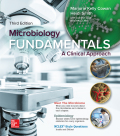
Microbiology Fundamentals: A Clinical Approach
3rd Edition
ISBN: 9781260163698
Author: Cowan
Publisher: MCG
expand_more
expand_more
format_list_bulleted
Concept explainers
Question
Chapter 10, Problem 18Q
Summary Introduction
To describe:
Alternative strategies to antibiotic treatments.
Introduction:
Many antibiotics are natural products of
Expert Solution & Answer
Want to see the full answer?
Check out a sample textbook solution
Students have asked these similar questions
Standard Concentration (caffeine) mg/L
Absorbance Reading
10
0.322
20
0.697
40
1.535
60
2.520
80
3.100
Please draw in the missing answer, thank you
Please fill in all blank questions, Thank you
Chapter 10 Solutions
Microbiology Fundamentals: A Clinical Approach
Ch. 10.1 - State the main goal of antimicrobial treatment.Ch. 10.1 - Identify the sources for the most commonly used...Ch. 10.1 - Describe two methods for testing antimicrobial...Ch. 10.1 - Prob. 4AYPCh. 10.1 - NCLEX PREP 1. An RN is caring for a 26-year-old...Ch. 10.2 - Explain the concept of selective toxicity.Ch. 10.2 - List the five major targets of antimicrobial...Ch. 10.2 - Prob. 7AYPCh. 10.2 - Distinguish between broad-spectrum and...Ch. 10.2 - Prob. 9AYP
Ch. 10.2 - Explain the mode of action of penicillinases and...Ch. 10.2 - Identify two antimicrobials that act by inhibiting...Ch. 10.2 - Prob. 12AYPCh. 10.2 - Identify one example of a fluoroquinolone.Ch. 10.2 - Describe the mode of action of drugs that target...Ch. 10.2 - Prob. 15AYPCh. 10.2 - Prob. 16AYPCh. 10.2 - Explain why antiprotozoal and antihelminthic drugs...Ch. 10.2 - List the three major targets of action of...Ch. 10.2 - Prob. 2NPCh. 10.3 - Discuss two main ways that microbes acquire...Ch. 10.3 - List five cellular or structural mechanisms that...Ch. 10.3 - Prob. 21AYPCh. 10.3 - Prob. 3NPCh. 10.3 - Prob. 1MMCh. 10.4 - Distinguish between drug toxicity and allergic...Ch. 10.4 - Prob. 23AYPCh. 10.4 - Prob. 4NPCh. 10.4 - Prob. 5NPCh. 10 - Microbial resistance to drugs is acquired through...Ch. 10 - Prob. 2QCh. 10 - Prob. 3QCh. 10 - Prob. 4QCh. 10 - Why does the penicillin group of antibiotics have...Ch. 10 - Prob. 6QCh. 10 - Prob. 7QCh. 10 - Conduct research to find out why drugs blocking...Ch. 10 - Prob. 9QCh. 10 - Prob. 10QCh. 10 - You take a sample from a growth-free portion of...Ch. 10 - Prob. 12QCh. 10 - Treating malarial infections is theoretically...Ch. 10 - Can you think of a situation in which it would be...Ch. 10 - Prob. 15QCh. 10 - Prob. 16QCh. 10 - Prob. 17QCh. 10 - Prob. 18QCh. 10 - An antimicrobial drug with a _______ therapeutic...Ch. 10 - Prob. 20QCh. 10 - Prob. 21QCh. 10 - Prob. 1VC
Knowledge Booster
Learn more about
Need a deep-dive on the concept behind this application? Look no further. Learn more about this topic, biology and related others by exploring similar questions and additional content below.Similar questions
- please fill in missing parts , thank youarrow_forwardplease draw in the answers, thank youarrow_forwarda. On this first grid, assume that the DNA and RNA templates are read left to right. DNA DNA mRNA codon tRNA anticodon polypeptide _strand strand C с A T G A U G C A TRP b. Now do this AGAIN assuming that the DNA and RNA templates are read right to left. DNA DNA strand strand C mRNA codon tRNA anticodon polypeptide 0 A T G A U G с A TRParrow_forward
- Please identify the curve shown below. What does this curve represent? Please identify A, B, C, D, and E (the orange oval). What is occurring in these regions?arrow_forwardPlease identify the test shown here. 1) What is the test? 2) What does the test indicate? How is it performed? What is CX? 3) Why might the test be performed in a clinical setting? GEN CZ CX CPZ PTZ CACarrow_forwardDetermine how much ATP would a cell produce when using fermentation of a 50 mM glucose solution?arrow_forward
- Determine how much ATP would a cell produce when using aerobic respiration of a 7 mM glucose solution?arrow_forwardDetermine how much ATP would a cell produce when using aerobic respiration to degrade one small protein molecule into 12 molecules of malic acid, how many ATP would that cell make? Malic acid is an intermediate in the Krebs cycle. Assume there is no other carbon source and no acetyl-CoA.arrow_forwardIdentify each of the major endocrine glandsarrow_forward
arrow_back_ios
SEE MORE QUESTIONS
arrow_forward_ios
Recommended textbooks for you
 Comprehensive Medical Assisting: Administrative a...NursingISBN:9781305964792Author:Wilburta Q. Lindh, Carol D. Tamparo, Barbara M. Dahl, Julie Morris, Cindy CorreaPublisher:Cengage Learning
Comprehensive Medical Assisting: Administrative a...NursingISBN:9781305964792Author:Wilburta Q. Lindh, Carol D. Tamparo, Barbara M. Dahl, Julie Morris, Cindy CorreaPublisher:Cengage Learning Microbiology for Surgical Technologists (MindTap ...BiologyISBN:9781111306663Author:Margaret Rodriguez, Paul PricePublisher:Cengage Learning
Microbiology for Surgical Technologists (MindTap ...BiologyISBN:9781111306663Author:Margaret Rodriguez, Paul PricePublisher:Cengage Learning

Comprehensive Medical Assisting: Administrative a...
Nursing
ISBN:9781305964792
Author:Wilburta Q. Lindh, Carol D. Tamparo, Barbara M. Dahl, Julie Morris, Cindy Correa
Publisher:Cengage Learning


Microbiology for Surgical Technologists (MindTap ...
Biology
ISBN:9781111306663
Author:Margaret Rodriguez, Paul Price
Publisher:Cengage Learning



Bacterial Genomics and Metagenomics; Author: Quadram Institute;https://www.youtube.com/watch?v=_6IdVTAFXoU;License: Standard youtube license